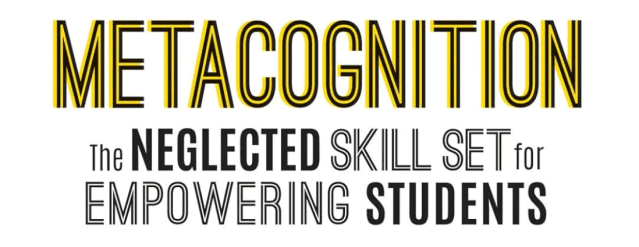Sorry for the “big word” but this is the secret skill all excellent CFIs use (even if they have not heard this term). “Metacognition” simply means “thinking about thinking.” This is a higher level of awareness that allows a person to transcend the present situation and acquire an overview. This is almost in the “third person;” observing from an outside reference point. This is how an excellent CFI knows upon entering the pattern on a 45° angle that their learner will be “high and unstable” 3 minutes before it happens. Metacognition is the CFI “spidey sense” that enables the split-brain capability, or the “all-seeing third eye.”
When we notice ourselves having an inner dialogue about our thinking and it prompts us to evaluate our learning or problem-solving processes, we are experiencing metacognition at work. This skill helps us think better, make sound decisions, and solve problems more effectively.

Metacognition is not (unfortunately) mentioned in the Aviation Instructor Handbook, but is the critical higher-level skill that enables safe aviation education both on the learner level and for the CFI. For empowered learning, metacognition builds learner motivation; empowering learners with the responsibility for their skill acquisition and growth -“incremental mastery!” If you read the blog on “situational awareness,” metacognition is the “meta” level of situational awareness (micro-macro-meta) that stands above the immediate attention to the present situation. Metacognition sees the bigger picture and adjusts current activities based on the timeline of future outcomes.
Metacognition is crucial for the design and implementation of appropriate educational and intervention techniques. Unless we adequately tailor our metacognitive skills, we cannot solve any problem, simply because we cannot understand what the problem really is. Accordingly, if the educator does not practice his/her own metacognitive skills first, he/she will not be able to assist the students properly MORE
So how do we develop and deploy this magic skill?
 The Aviation Instructor’s Handbook never addresses metacognition directly. This aptitude resides in the HOTs (Higher Order Thinking Skills – prefrontal cortex) part of the human brain. If you look at page 3-24 “Stages of Skill Acquisition” you get an idea of where this would occur in the hierarchy of skill acquisition. The first step in learning any skill is deliberate rote practice; monkey see, monkey do. This progresses into a habitual automatic performance of familiar tasks. At the expert level skills are performed in a fluid and subconscious performance.
The Aviation Instructor’s Handbook never addresses metacognition directly. This aptitude resides in the HOTs (Higher Order Thinking Skills – prefrontal cortex) part of the human brain. If you look at page 3-24 “Stages of Skill Acquisition” you get an idea of where this would occur in the hierarchy of skill acquisition. The first step in learning any skill is deliberate rote practice; monkey see, monkey do. This progresses into a habitual automatic performance of familiar tasks. At the expert level skills are performed in a fluid and subconscious performance.
 Dr. Gary Klein created a method for deconstruction expert piloting skills in the 1970s during the first gas crisis. Under a contract with the USAF, he studied “What makes an expert different from a beginner, and can these skills be harvested and transmitted more effectively.” His Cognitive Task Analysis drilled down into this “acquired automaticity” found in expert aviators and discovered the presence of metacognition in expert performers.
Dr. Gary Klein created a method for deconstruction expert piloting skills in the 1970s during the first gas crisis. Under a contract with the USAF, he studied “What makes an expert different from a beginner, and can these skills be harvested and transmitted more effectively.” His Cognitive Task Analysis drilled down into this “acquired automaticity” found in expert aviators and discovered the presence of metacognition in expert performers.
It turns out that tasks created intentionally with endless repetition in the cortex (HOTS) are subsequently stored in the brain’s striatum like books on a shelf. These skills are available for fluid execution at a future date. The expert performer can access these scripts to perform a task fluidly while adding levels of perfection and polish invisible to the beginner.
This expert-level performance is enabled through the myelination of necessary neural pathways; basically “broadband speed” neural circuits 300X faster than initial execution. Everything we think or do is a neural pathway. At the expert level, mental resources are freed up for metacognition; global oversight. A performer at this level can iterate skill execution in a manner indistinguishable to a beginner (Recognition-primed decision RPD). A master performer can simultaneously”see the whole picture.” When you watch Rob Holland fly aerobatics, or an Olympic athlete perform, this is how that performance is possible.
 To be truly excellent and safe, a CFI needs to reach a level of skill performance that frees up mental resources to see beyond the moment. This metacognition allows a CFI to forecast the trajectory of the flight, both in terms of the maneuver and energy, but also anticipate the learner’s next moves. Some level of this skill should be present in a CFI applicant testing for an initial certificate. If an applicant is still struggling to perform a maneuver, or cannot fly and talk at the same time (babbling), they have not yet reached a safe level of educator. And the temporary CFI certificate is only the “student teacher” level of skill. Hours of on-the-job teaching build a much stronger skill set for an excellent educator. Fly safely out there (and often)!
To be truly excellent and safe, a CFI needs to reach a level of skill performance that frees up mental resources to see beyond the moment. This metacognition allows a CFI to forecast the trajectory of the flight, both in terms of the maneuver and energy, but also anticipate the learner’s next moves. Some level of this skill should be present in a CFI applicant testing for an initial certificate. If an applicant is still struggling to perform a maneuver, or cannot fly and talk at the same time (babbling), they have not yet reached a safe level of educator. And the temporary CFI certificate is only the “student teacher” level of skill. Hours of on-the-job teaching build a much stronger skill set for an excellent educator. Fly safely out there (and often)!
8 Pillars of Metacognition, Gary Kline
 See you at Sun ‘N Fun 2025! SAFE will be in the “Bravo Hangar” right in the center #80-81.
See you at Sun ‘N Fun 2025! SAFE will be in the “Bravo Hangar” right in the center #80-81.
FREE ice cream at our “SAFE CFI Roundup” (Sat. 1600 @ Prop 75) with lots of CFI news (speakers) and Q&A discussion. Register to attend and win a Lightspeed Delta Zulu headset (and other prizes). 



